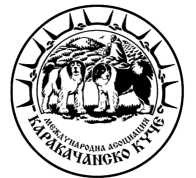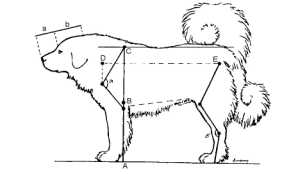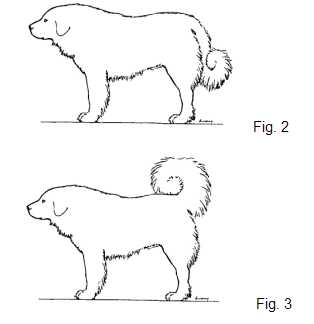
Karakachan
Dog Breed Standard Karakachan Dog International Association |
|
||
|
Synonyms: Ovcharsko kuche, Chobansko kuche, Vlashko kuche, Thracian Mollos, Karakachan Dog, Karakatschan Hund, Chien Karakatschan, Authors of the standard: V. Dintchev, S. Sedefchev, A. Sedefchev, S. Stoev - 14. 01. 2000 (with amendments) Date of publication of the first original valid standard: 26.06. 1991, Thracian University, Stara Zagora. Utilization: used as a watch and a guard dog for livestock, houses and a companion for people. Classification
FCI: Group 2 Pinscher and Schnauzer- Molossoid breeds- Swiss
Mountain and Cattle Brief
historical survey: The Karakachan Dog is one of Europe's oldest
breeds. A typical Mollos, created for guarding its owner's flock
and property, it does not hesitate to fight wolves or bears to defend
its owner and his family in case of danger. Its ancestors started
forming as early as the third millennium BC. The Karakachan Dog
is a descendant of the dogs of the Thracians - the oldest inhabitants
of the Balkan peninsula, renowned as stock-breeders, whom Herodotus
describes as the most numerous people after the Indian one. The
Proto-Bulgarians also played an essential part in the formation
of the Karakachan Dog as they brought their dogs with them at the
time of their migration from Pamir and Hindukush. General appearance: A massive dog. Harmoniously and proportionally built. It looks impressive and powerful. It's powerfully muscled, with bones that are massive but not coarse. Extremely undemanding and easy to keep. |
|||
| Important
proportions: The length of the body
measures the same as the height at withers + X% - in male dogs X = 4-10% - in bitches X=6 - 15 % - the height at the elbow = 52-55% of the height at withers - the length of the muzzle = 43-45% of the length of the head |
|
||
 |
|||
|
Behaviour/ temperament: proud, domineering, weary to strangers, brave and intelligent dog of tough, steady and independent character. It's got a typical deep solid bark. Head: Body: Withers: Well-pronounced, long and muscular. Back: Straight, broad and well-muscled. Loins: Of medium length, broad, well-muscled. Pronounced above the upper line. Croup: Of medium length, broad and slightly sloping. Rounded and muscular. Chest: Deep and broad but not barrel-shaped. Reaching deep at least to the points of elbow. Under line and belly: The belly is muscular, taut and slightly tucked up. Tail: Not very high set. It reaches to the hock joints but can also be short by birth. The coat on tail is long and rough. In repose it hangs low or the tip is curved(Fig.2). In movement or when the dog is alert, it is carried over the back in sabre form or curled(Fig.3).
|
|||
 |
|||
|
Limbs: Forequarters: Straight, parallel, massive. Shoulders and upper arm: Long and broad. Tightly joined to the body, well-muscled. Angle between shoulder blade and shoulder bone is approximately 105°. Elbow: Close-fitting to chest. Forearm: Long, bone-sturdy. Carpus: Strong and broad. Pastern: Slightly sloping. Broad and strong. Front feet: Large, round, with taut, compact toes. Arched and hairy. Elastic dark pads. Toenails are thick and strong, preferably dark-coloured. Hindquarters: Parallel, powerful, with moderate angulation. Thigh: Of medium length, broad, well-muscled. Lower thigh: Long, broad and muscular. Hock: Broad and taut. The tibial-tarsus angle is about 140°. Hind pastern: Of medium length, massive, slightly obliquely set. Hind feet: Longer than the front feet, with taut, compact toes. Often with single or double dewclaws. Good feathering between the toes. Gait/movement: Long reaching. Preferred movement is the springy trot. Skin: Thick, elastic and closely-fitting. No flabs apart from a slight dewlap along the lower (ventral) part of the neck. The nose leather and the visible mucus membranes should be black-pigmented and for red-white dogs should be brown. Coat:
longhaired
- length of coat on the body should measure over 12 cm.
Colour of hair: Two or tricolour, with spots. Most desired are clearly defined dark spots on white or big white spots on dark. Height
at the withers: Weight:
Males: 40-55 kg Faults:
Any departure from the foregoing points should be considered a fault
and the seriousness with which the fault should be regarded should
be in exact proportion to its degree. Eliminating
faults |
|
©
2005 Semperviva
|